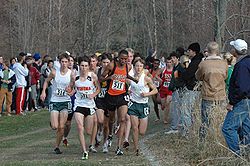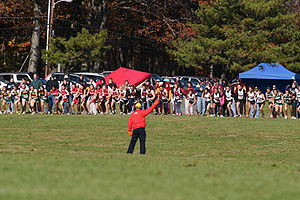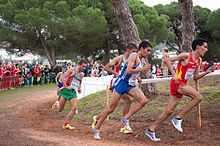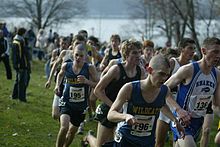- Cross country running
-
This article is about cross country running. For other uses, see Cross country.
Cross country running is a sport in which runners race on open-air courses over natural terrain. The course, typically 4–12 kilometres (2.5–7.5 mi) long, may include surfaces of grass and earth, pass through woodlands and open country, and include hills, flat ground and sometimes gravel road. It is both an individual and a team sport, as runners are judged on an individual basis and a points scoring method for teams. Both men and women of all ages compete in cross country, which usually takes place during autumn and winter, and can include weather conditions of rain, sleet, snow or hail, and a wide range of temperatures.
Cross country running is one of the disciplines under the umbrella sport of athletics, and cross country athletes often compete in long-distance track and road running. Although open-air running competitions are pre-historic, the rules and traditions of cross country racing emerged in Britain. The English championship became the first national competition in 1876 and the International Cross Country Championships was held for the first time in 1903. Since 1973 the foremost elite competition has been the IAAF World Cross Country Championships.[1]
Contents
Race course
Cross country courses generally are laid out on an open or woodland area. The IAAF recommends that courses be grass-covered, and have rolling terrain with frequent but smooth turns. Courses consist of one or more loops, with a long straight at the start and another leading to the finish line.
Distances
Courses for international competitions consist of a loop between 1750 and 2000 meters. Athletes complete three to six loops, depending on the race. Senior men compete on a 12-kilometre course. Senior women and junior men compete on an 8-kilometre course. Junior women compete on a 6-kilometre course.[2]
In the United States, college men typically compete on 8 km (5.0 mi) or 10 km (6.2 mi) courses, while college women race for 5 km (3.1 mi) or 6 km (3.7 mi).[3] High school courses may be as short as 2.5 km (1.6 mi), but the most common distance is 5 kilometers (3.1 mi) (although a few states, such as California, race 3 miles (4.8 km)).For example in Dublin High School, CA the freshmen and sophomores run 2 miles on races(boys and girls)and junors and seniors run 3 miles(boys and girls). [4]
Start
All runners start at the same time, from a starting arc (or line) marked with lanes or boxes for each team or individual. An official, 50 metres or more in front of the starting line, fires a pistol to indicate the start. If runners collide and fall within the first 100 metres, officials can call the runners back and restart the race. Crossing the line or starting before the starting pistol is fired most often results in disqualification of the runner.
Finish
The course ends at a finish line located at the beginning of a funnel or chute (a long walkway marked with flags) that keeps athletes single-file in order of finish and facilitates accurate scoring.
Depending on the timing and scoring system, finish officials may collect a small slip from each runner's bib, to keep track of finishing positions. An alternative method (common in the UK) is to have four officials in two pairs. In the first pair, one official reads out numbers of finishers and the other records them. In the second pair, one official reads out times for the other to record. At the end of the race the two lists are joined along with information from the entry information. The major disadvantage of this system is that distractions can easily upset the results, particularly when large numbers of runners finish close together.
Chip timing has grown in popularity to increase accuracy and decrease the number of officials required at the finish line. Each runner attaches a transponder with RFID to his or her shoe. When the runner crosses the finish line an electronic pad records the chip number and matches to the runner to a database. Chip timing allows officials to use checkpoint mats throughout the race to calculate split times, and to ensure runners cover the entire course. This is by far the most accurate method, although it is the most expensive.[5]
Scoring
Scores are determined by summing the top four or five individual finishing places on each team. In international competition, a team typically consists of six runners, with the top four scoring. In the United States, the most common scoring system is seven runners, with the top five scoring. Points are awarded to the individual runners of eligible teams, equal to the position in which they cross the finish line (first place gets 1 point, second place gets 2 points, etc.). The points for these runners are summed, and the low score wins. Individual athletes, and athletes from incomplete teams are excluded from scoring. Ties can be broken in several ways. In international competition, ties are resolved in favour of the team whose last scoring member finishes nearer to first place. In high school competition, ties are resolved in favor of the team whose next non-scoring member finishes first. In U.S. college competition, ties are not resolved.[3]
The lowest possible score in a five-to-score match is 15 (1+2+3+4+5), achieved by a team's runners finishing in each of the top five positions. If there is a single opposing team then they would have a score of 40 (6+7+8+9+10), which can be considered a "sweep" for the winning team. In some competitions a team's sixth and seventh runner are scored in the overall field and are known as "pushers" or "displacers" as their place can count ahead of other runners. In the above match, if there are two non-scoring runners and they came 6th and 7th overall, the opponent's score would be 50 (8+9+10+11+12). Accordingly, the official score of a forfeited dual meet is 15-50.
Strategy
Because of differences between courses in running surface, frequency and tightness of turns, and amount of up and downhill, cross country strategy does not necessarily simplify to running a steady pace from start to finish. Coaches and cross country runners debate the relative merits of fast starts to get clear of the field, versus steady pacing to maximize physiological efficiency. Some teams emphasize running in a group in order to provide encouragement to others on the team, while others hold that every individual should run his or her own race.[6][7][8]
Training and Form
As far as off the course strategy is concerned, core workouts are incredibly helpful when it comes to improving. Integrating core workouts into training regiments helps to improve running form, endurance and may even improve one’s ability to push themselves while running.
One of the most important qualities of running is form, and this is even more true when it comes to long distance running. Core workouts strengthen muscles and help to promote good running posture. As races or practices drag on, one’s form starts to naturally diminish as their body attempts to rest which can lead to less efficient training sessions. However, practicing core workouts in addition to running can help to combat this diminishing of form by making the muscles that promote this posture more ready for the long runs. The endurance of a long distance runner’s legs is unparalleled, however, the upper body (which is still part of the running form) is less focused on and, therefore, less efficient.
Endurance is what separates two runners of equal skills. They may both be as fast and can handle the distance, however, if one of the runners can push themselves a little bit more than his or her counterpart, they will win that battle. Core workouts offer that endurance by calling on a will that is very integral to running, the will to push oneself. Now, the point of the core workouts are to strengthen the body, however, it is more of a repetitious process for runners than a strengthening process. The goal is to tone the body and improve cardiac endurance rather than increase muscle mass. This endurance helps to fine tone the will of the runner to maintain a good form while running and to go stronger for longer because it takes more to wear out the body if one’s core is strong.
Pushing oneself in a race is easy to talk about but incredibly difficult to achieve. Any runner who has been in the middle of a race after they have exhausted themselves knows that digging even further within their body to bring out more strength in order to go even harder and even faster seems impossible when one is already gasping for air and every muscle in their body is burning. Core workouts can help to train the body to withstand more abuse which leads to the runner having more of an ability to push themselves because by the second mile, they have that much more energy than one who does not practice core workouts. Additionally, when the muscles are more conditioned to handle the physical draw of a race, they take longer to break down which leaves the runner with more to give during the race.
There are many different ways to strengthen the core of the body. Most of them, especially so for runners, are manual workouts. Things like push-ups, sit-ups and tricep presses go a long way because they call on the strength of the runner carrying the weight of the runner (which is also the case during a race). Additionally, the manual workouts will help to focus more on repetition and endurance rather than building up muscle mass. The number of sets and repetitions are up to the individual runner as each runner would likely vary in capabilities. However, so long as the runner is working to push himself or herself, the workout should be beneficial.
As most runners know, the abilities one has in a race rely heavily on the training they take part in off the course. Core workouts are merely another set of training tactics which can really improve a runner’s ability and strengths in a race.
Equipment
Cross country running involves very little specialized equipment. Most races are run in shorts and vests or singlets, usually in club or school colors. In particularly cold conditions, long-sleeved shirts and tights can be worn to retain warmth without losing mobility. The most common footwear are cross country spikes, lightweight racing shoes with a rubber sole and approximately six metal spikes screwed into the forefoot part of the sole. Spike length depends on race conditions, with a muddy course appropriate for spikes as long as 25 millimetres (0.98 in). If a course has a harder surface, spikes as short as 6 millimetres (0.24 in) may be most effective. While spikes are suitable for grassy, muddy, or other slippery conditions, runners may choose to wear racing flats, rubber-soled racing shoes without spikes, if the course includes significant portions of paved surfaces or dirt road.[4]
History
While humans have raced each other over natural terrain since before recorded history, formal cross country competition traces its history to the 19th century and an English game called "hare and hounds" or "the paper chase". English schools started competing in cross country races in 1837, and established a national championship in 1876.[9]
Olympic Games
Cross country was contested as a team and individual event at the 1904, 1912, 1920 and 1924 Summer Games. A United States team won the gold medal for cross country in the 1904 Olympics. Sweden took gold in 1912. Finland, led by Paavo Nurmi, captured the gold in 1920 and 1924 before the Olympics dropped cross country from its program.[10]
World Championships
Europeans dominated early International Cross Country Championships, first held at the Hamilton Park Racecourse in Scotland on 28 March 1903. England won the first 14 titles, and 43 of 59 until the IAAF took over the competition in 1973. France was the next most successful country in the early years, winning 12 championships between 1922 and 1956. Belgium is the only other country to win at the International Cross Country Championship, capturing titles in 1948, 1957, 1961 and 1963. The English also dominated the individual competition, with an Englishman winning the individual title 35 times, including three wins by Jack Holden (1933–1935).
The first international cross country championship for women was held in 1931, and thirteen more times through 1972. England won 12 of these early championships, losing only in 1968 and 1969 (to the United States). American Doris Brown won five consecutive individual titles between 1967 and 1971.
Beginning in 1973, the IAAF began hosting the renamed World Cross Country Championships each year. In 1975 the New Zealand men and United States women won, marking the first championships by non-European countries. In 1981 an African nation (Ethiopia) won the men's race for the first time, and a decade later an African nation (Kenya) won the women's race for the first time. Ethiopia or Kenya has captured every men's title since 1981 and every women's title since 2001. Through 2010, Kenya has won 40 World Cross Country Championships and Ethiopia has won 23.[11]
Notable athletes
Men
- Kenenisa Bekele – won both short and long World Cross Country course titles in the same year five times (2002–2006), after a junior men victory and senior long course silver in 2001. The IAAF calls him the "greatest ever male cross country runner to have graced the sport."[12]
- Carlos Lopes – first man to win World Cross Country title three times.
- John Ngugi – first man to win five World Cross Country titles, including four consecutively in the late 1980s.
- Steve Prefontaine – three-time NCAA cross country champion and subject of the movies Prefontaine and Without Limits.
- Gaston Roelants – four-time champion at the International Cross Country Championship between 1962 and 1972.
- Paul Tergat – long course champion five years in a row (1995–1999), plus a bronze medal finish in 2000.
Women
- Doris Brown – won the International Cross Country Championship for five consecutive years (1967–1971).
- Zola Budd – young prodigy who twice won women's World championship (1985–1986), known for running barefooted.
- Tirunesh Dibaba – won three times at the World long course and once at the short.
- Lynn Jennings – won World title three times.
- Edith Masai – won the World short race three times.
- Derartu Tulu – won World titles three times in six years (1995, 1997, 2000).
- Grete Waitz – first athlete to win five IAAF World Cross Country titles.
- Gete Wami – won twice at the World long course and once at the short.
Regional organization
In addition to the World Cross Country Championships, the IAAF sponsors six annual area-level competitions: the African Cross Country Championships, Asian Cross Country Championships, European Cross Country Championships, NACAC Cross Country Championships, Oceania Cross Country Championships and South American Cross Country Championships.
Beyond championships, IAAF world cross country meetings include the Great Edinburgh International Cross Country, Cross Internacional de Itálica, Antrim International Cross Country, Cinque Mulini, Nairobi Cross, Chiba International Cross Country, Fukuoka International Cross Country meet, Eurocross and Almond Blossom Cross Country.[13]
Australia
Cross country running is organised at the state level by the athletics association for each state. In Queensland this Queensland Athletics.[14] In the Masters category (over 30), this is organised by Australian Masters Athletics. Brisbane will host the Australian Masters Nationals Championships,[15] April 21–24, 2011 with the Cross Country hosted by Thompson Estate and Eastern Suburbs Athletics [16] at Minnippi Parklands.
The cross country season in Brisbane is usually March - September. During the season there is usually one race each week in a different park, normally organised and hosted by one of the participating clubs. Photos of such events can be found here.[17]
Canada
Cross country running is a far reaching sport in Canada. Starting in elementary school, most children have had some form of exposure to cross country running, usually in the form of an annual all-school event. In middle school, races are more serious and are divided by grade and gender. In high school the races are very serious and tend to be the main talent pool (especially at the senior level) for university or national-level runners. At the university level, the sport is administered by Canadian Interuniversity Sport.[18]
United Kingdom
The organization of cross country running in the United Kingdom has continued to be mostly devolved to the four national associations: England, Wales, Scotland, and Northern Ireland. The sport is based around the clubs, which usually are mixed cross country and road running clubs. The current position (which is changing) is that in England, the English Cross Country Association is part of the Amateur Athletic Association.
Cross country running takes place from roughly September until March. Most matches are parts of different cross country leagues, which are organised on an ad hoc basis. These vary from large, high quality leagues, such as the London Metropolitan Cross Country League, Birmingham League and Surrey League (which is unusual in requiring ten runners to score) to small, local leagues (such as the Gloucestershire AA league), and individual clubs can be a member of several leagues.
Typically there will be four or five fixtures a season. In addition there are county championships, area championships (north, south, and midlands), the national championship (whose location rotates around the three areas), and the Inter-Counties Championship (which is often the best quality race owing to its restricted entry and its role as the trial for the World Championships).
In addition there can be many inter-club matches, particularly among the older clubs. Most league matches are around 10 km (6.2 mi) long, and most championships 12 to 15 km (c. 7½ to 9 miles) long. Most clubs are mixed, though men's and women's races tend to be run separately.
Secondary school aged students are also to compete at local schools races, with a set number of students qualifying for county level, at which there is a further race to qualify for the English Schools Cross Country race. There is also quite a lot of racing between universities, with larger fixtures organised through BUCS.
United States
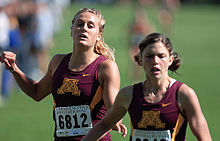 Roy Griak Invitational cross country meet, University of Minnesota
Roy Griak Invitational cross country meet, University of Minnesota
USA Track & Field hosts four annual national cross country championships. The USA Cross Country Championships, first held in 1890, include six races: masters women (8 km), masters men (8 km), junior women (6 km), junior men (8 km), open women (8 km) and open men (12 km). In addition to crowning national champions, the championships serve as the trials race to select the Team USA squad for the IAAF World Cross Country Championships. The USA Masters 5 km Cross Country Championships, first held in 2002, include a men's race and a women's race. The USATF National Club Cross Country Championships, first held in 1998, feature the top clubs from across the United States as they vie for honors and bragging rights as the nation's top cross country team. The USATF National Junior Olympic Cross Country Championships, first held in 2001, has races for boys and girls in five different two-year age divisions.[19]
Most American universities and colleges field men's and women's cross country teams as part of their athletic program. Over 900 men's cross country teams and over 1000 women's cross country teams compete in the three divisions of the National Collegiate Athletic Association.[20] Men usually race 10 km (6.2 mi) or 8 km (5.0 mi), and women usually race 6 km (3.7 mi) or 5 km (3.1 mi).[3] The season culminates in men's and women's championships.
Every state offers cross country as a high school sport for boys and girls. Over 440,000 high school students compete in cross country each year, making it the sixth most popular sport for girls, and seventh most popular for boys.[21] The standard high school cross country race distance is 5 km (3.1 mi), though some states run a shorter, 3- to 4-kilometer course for girls. Beginning in 1979, the Foot Locker Cross Country Championships have offered a national championship for high school cross country runners. Since 2004, the Nike Cross Nationals have offered an alternative national championship, focused on teams rather than individuals. A 2008 film, The Long Green Line, documented the success of Joe Newton, cross country coach at York Community High School in Elmhurst, Illinois.[22]
While many middle schools (grades 6-8) in the U.S. offer cross country as a school sport, youth running clubs dominate in this age group. A typical middle school course is 3 km (1.9 mi), and races may not split up boys and girls. Few elementary schools in the U.S. have school teams, but many running clubs exist for youth runners. Youth running clubs compete in local, regional, and national championships sanctioned by the AAU or USATF. Course distances for this age group vary depending on the age of the athlete. Common championship distances are:
Group Ages Race Distance Bantam Under 10 3 km (1.9 mi) Midget 10 to 12 3 km (1.9 mi) Youth 12 to 14 4 km (2.5 mi) Intermediate 14 to 16 5 km (3.1 mi) Young 16 to 18 5 km (3.1 mi) Mt. San Antonio College in Walnut, California hosts the largest cross country invitational in the United States, with over 22,000 runners from community colleges, high schools and elementary schools competing. The meet started in 1948 and continues today.[23]
Outstanding American cross country runners include Don Lash, who won seven consecutive national championships from 1934 to 1940 and Pat Porter, who won eight titles from 1982 to 1989. Only two American athletes have won the IAAF World Cross Country Championships: Craig Virgin, who won in 1980 and again in 1981 and Lynn Jennings from 1990–1992.
Variations
One variation on traditional cross country is mountain running, which incorporates significant uphill and/or downhill sections as an additional challenge to the course. Orienteering is another competitive sport similar to cross country, although it features an element of navigation absent from the set and marked courses of cross country.[24]
References
- ^ Cross country - Introduction. IAAF. Retrieved 14 February 2011.
- ^ IAAF Competition Rules 2010-2011. IAAF. Retrieved 27 February 2011.
- ^ a b c 2011/2012 NCAA Men’s and Women’s Track & Field and Cross Country Rules. NCAA. Retrieved 11 February 2011.
- ^ a b 2011 NFHS Track & Field and Cross Country Rules Book. NFHS.
- ^ USA Track & Field 2011 Competition Rules. USATF. Retrieved 27 February 2011.
- ^ Groves, Harry. Tactics & Strategy. Cross Country Journal Vol II, Num 2. July–August 1984.
- ^ Mackenzie, Brian. Cross Country – Tactical approach. Retrieved 4 March 2011.
- ^ Newton, Joe with Joe Henderson (1998). Coaching Cross Country Successfully. Human Kinetics. pp. 83–88. ISBN 978-0880117012.
- ^ History - Cross-Country Running HickockSports.com.
- ^ Olympic.org Medallists database Olympic Movement.
- ^ USATF Cross Country Championships Media Handbook. USATF. Retrieved 12 February 2011.
- ^ Cross country - Landmarks IAAF.
- ^ IAAF Calendar. IAAF.
- ^ Queensland Athletics
- ^ Australian Masters Nationals Championships
- ^ Thompson Estate Athletics, Brisbane athletics and cross country running club
- ^ Thompson Estate Athletics, Brisbane athletics and cross country running club photos
- ^ CIS Cross Country Championships. CIS. Retrieved 27 February 2011.
- ^ USA Track & Field - Cross Country USATF.
- ^ NCAA Sports Sponsorship. NCAA. Retrieved 14 February 2011.
- ^ National Federation of State High School Associations NFHS.
- ^ The Long Green Line (2008) - IMDb IMDB.
- ^ About The Mt. SAC Cross Country Invitational Mt. San Antonio College.
- ^ Mountain Running - Introduction. IAAF. Retrieved 15 February 2011.
International cross country running IAAF World Cross Country Championships Asia AAA – Asian Cross Country Championships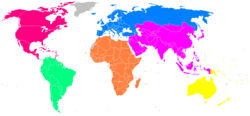
Africa CAA – African Cross Country ChampionshipsNorth America South America CONSUDATLE – South American Cross Country ChampionshipsOceania OAA – Oceania Cross Country ChampionshipsEurope EAA – European Cross Country Championships • Nordic Cross Country Championships • Balkan Cross Country ChampionshipsWorld FISU World University Cross Country Championships • Commonwealth Mountain and Ultradistance Running Championships • CISM World Military Cross Country ChampionshipsSee also: Modern pentathlon • International Cross Country Championships (1903–1972) Events in the sport of athletics Track and field · Road running · Race walking · Cross country running Track Sprints Hurdles 50 m · 55 m · 60 m · 100 m · 110 m · 400 mMiddle distance Long distance Relays 4 × 100 m · 4 × 200 m · 4 × 400 m · 4 × 800 m · 4 × 1500 m · Distance medley relay · Sprint medley relay · Swedish relayField Throws Jumps Combined Road Running Walking 10 km · 20 km · 50 kmMultiday race · Ultramarathon · Wheelchair racing · Backward running Racing Running Track running Off-road runningOther
Off-road runningOtherOrienteering Foot orienteering · Mountain bike orienteering · Ski orienteering · Trail orienteering · Radio orienteering · Canoe orienteering · Rogaining · Mountain marathon · Car orienteeringBicycle racing Animal racing Swimming Motorsport Red Bull Air Race World Championship · Schneider Trophy Motorboat racingDrag boat racing · Hydroplane racing · Jet sprint boat racing · Offshore powerboat racing · F1 Powerboat World ChampionshipOther
Motorboat racingDrag boat racing · Hydroplane racing · Jet sprint boat racing · Offshore powerboat racing · F1 Powerboat World ChampionshipOtherMulti-sport racing List of forms of racing Categories:- Cross country running
- Running
- Athletic sports
- Team sports
- Athletics by type
Wikimedia Foundation. 2010.

